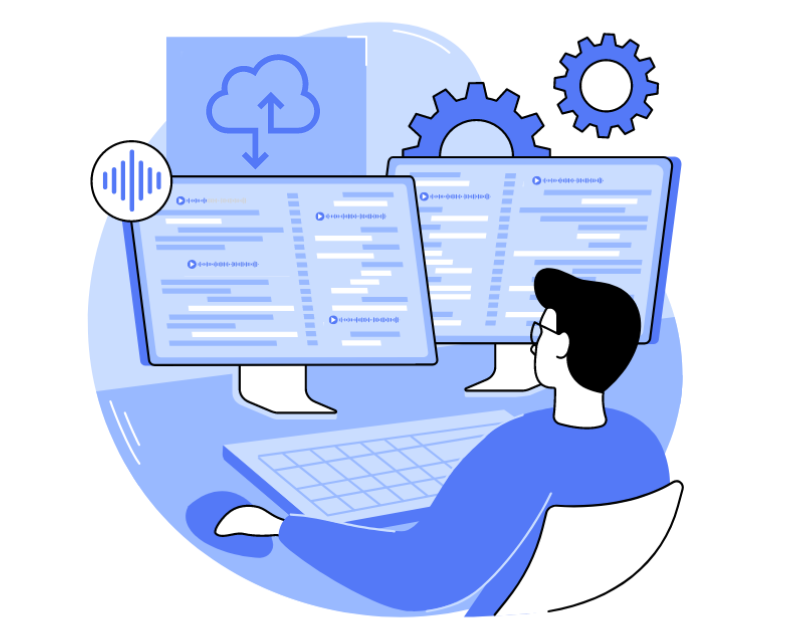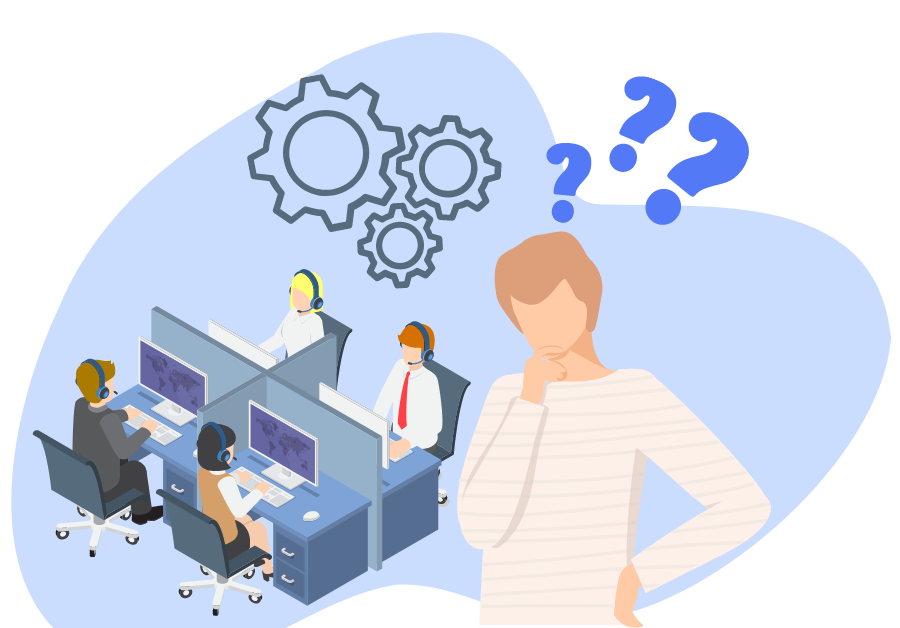1. What is a “Remote Call Center”?
2. Advantages of Remote Management for Agents and Supervisors
3. Challenges in Remote Management of Contact Center Agents
4. What is a Cloud Service for Call and Contact Centers: Advantages and Opportunities
5. A Set of Skills and Tools for Effective Remote Management by Contact Center Managers
6. The Impact of Remote Management on KPIs and Productivity of the Call Center
7. The Role of the Supervisor in Remote Management of Call Center Agents
8. Strategies and Methods for Effective Remote Management
9. Measuring and Evaluating the Quality of Remote Contact Center Services
10. Technologies and Methods of Quality Control in a Remote Call Center
11. Supporting Agents’ Engagement and Motivation at Distance.
12. Advantages of Using the Oki-Toki Service for Remote Contact Center Control
13. Three implemented cases of successful use of Oki-Toki service
What is a «Remote Call Center »?
A remote call center is a model of contact center or call center operation, where agents perform their duties from a remote location, outside of a physical office. This mode of operation is becoming increasingly popular in modern business, and this trend can be attributed to a range of benefits it offers.
It is important to note that for a remote call center to operate effectively, it requires good organization and the use of specialized tools. A reliable communication system, cloud services for managing calls, call recording and analytics allow managers to monitor agent performance and ensure a high level of service.
Of course, there are some issues associated with remote work. For instance, it is necessary to set clear procedures and rules for employee work, as the inability to directly supervise can impact discipline and productivity. However, with the use of modern management tools and feedback, these challenges can be successfully overcome.
Advantages of remote management for agents and supervisors
Remote management is becoming increasingly common and demanded in modern call centers, contact centers, sales departments, and other organizations where efficient communication with customers plays a key role. Implementing remote management can provide numerous benefits for agents and supervisors, ensuring more flexible and efficient work.
Here are some of the main benefits of remote management for call center agents and supervisors:
- Workplace flexibility: Remote management allows agents and supervisors to work from any location where there’s internet access. This comes in particularly handy when organizing work from home or during business trips. Workplace flexibility enhances productivity and staff satisfaction, and it also enables companies to attract and retain talented employees.
- Improving Accessibility: Remote management allows agents and supervisors to be accessible at any time and from anywhere in the world. This is particularly important for international companies or organizations with clients in different time zones. Thanks to remote management, agents and supervisors can respond to customer inquiries instantly, enhancing service and increasing customer satisfaction.
- Effective Management and Monitoring: Remote management enables supervisors to observe the work of agents and monitor the quality of service in real-time. Using specialized software solutions and cloud services, supervisors can receive statistical information about agent performance, analyze operational efficiency, and make adjustments to enhance results. This allows for the optimization of processes in the call center and improves service quality.
- Cost reduction: Remote management can significantly lower costs associated with property and equipment rentals. There’s no need for agents and supervisors to travel to the office every day, allowing for savings on utility bills, transport costs and commuting time. Additionally, companies can cut down on expenses for hardware infrastructure upkeep by shifting this responsibility to cloud services provided by specialized providers.
- Expanding recruitment possibilities: Remote management allows companies to attract talented employees from different geographical regions, not limited to the local labor market only. Thanks to the possibility of remote work, call centers and contact centers can recruit staff with the necessary skills and experience, regardless of their location. This broadens the pool of potential candidates and allows companies to form strong teams.
Challenges in Remote Management of Contact Center Agents.
Remote management of contact center agents presents a series of challenges that require particular attention and problem-solving focus. The operations of remote agents can become difficult due to the lack of direct control and communication in an office environment. Let’s examine some of these problems and propose solutions to overcome them.
- Limited Communication and Coordination: In a remote setup, agents lose the ability to quickly communicate with colleagues and supervisors, which may lead to delays in customer issue resolution. To tackle this challenge, it’s suggested to use communication tools such as chats, video conferencing, and corporate social networking. This will enable agents to share information swiftly, ask questions, and get the needed support from colleagues and leadership.
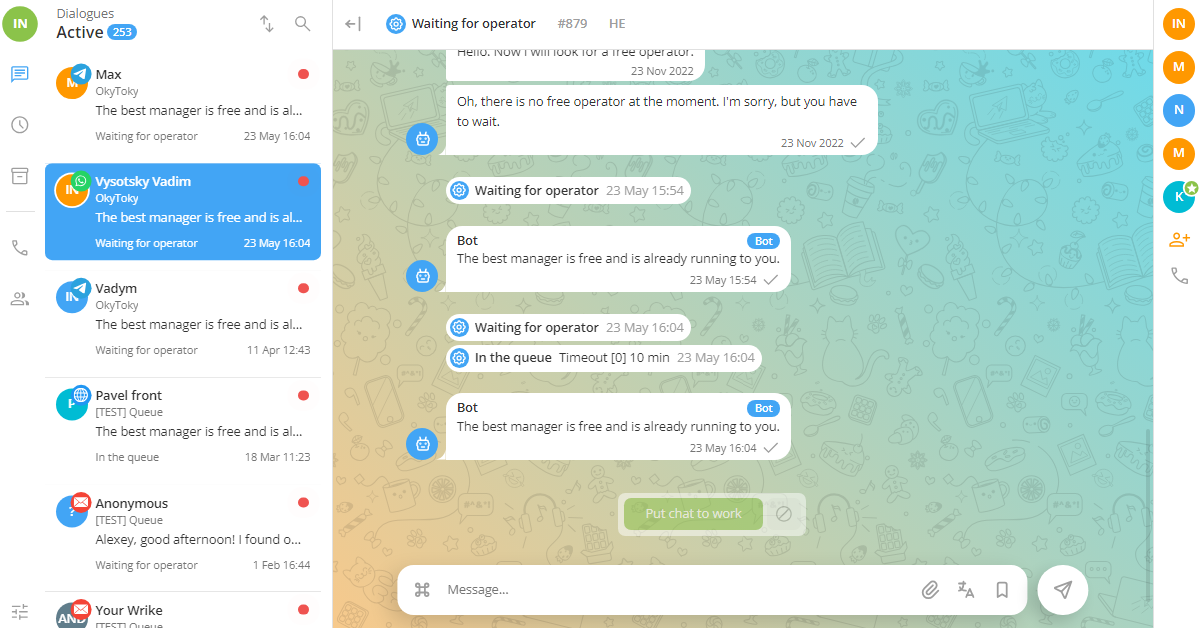
- Limited control and motivation: Without direct supervision from the manager, remote Operators may lack motivation and self-discipline. To increase control and maintain motivation, it is recommended to use specialized performance management tools, such as monitoring, analytics and reporting systems. These tools allow you to track operator key performance indicators and provide them with feedback to improve performance.
- Technical Issues and Issues: In a remote environment, operators may encounter technical issues such as network outages, software or hardware issues . To reduce the likelihood of such problems occurring, it is recommended that the technical infrastructure be regularly maintained and updated. In addition, it is necessary to provide operators with access to reliable technical support that can quickly respond to and resolve problems.
- Data Security and Privacy:Remote operators have access to sensitive customer data, so strict security measures are necessary to prevent data leaks. It is recommended to use secure communication channels, multi-factor authentication, data encryption and regular training of employees on information security issues.
Examples of cases from real practice:
- XYZ company, an online store, solved the problem of limited communication by introducing corporate chat and video conferencing systems for their remote operators. This allowed operators to quickly consult with colleagues and management, which improved the quality of customer service.
- ABC Company, a financial entity, addressed the problem of limited control and motivation by implementing a performance monitoring system and giving operators access to their personal performance indicators. This allowed operators to better control their work and maintain a high level of motivation.
So, for successful remote management of operators, contact The center needs to solve communication, control, technical problems and ensure data security. Using specialized tools and providing access to reliable technical support will help minimize emerging problems and ensure effective work of remote contact center agents.
What is cloud service for call centers and contact centers: advantages and opportunities
Cloud service for call centers and contact centers is an innovative solution that allows organizations to effectively manage their customer service. It provides many benefits and opportunities, opening up new horizons for sales departments, supervisors and managers.
One of the main advantagescloud service is its flexibility and scalability. The service is based in the cloud, which means there is no need for large investments in hardware and software. This is especially useful for small companies or startups that find it difficult to allocate significant funds for the purchase and maintenance of equipment. The cloud service allows you to quickly scale operations and adapt them to growing business needs.
Another significant advantage is geographic flexibility. Employees can work remotely from anywhere in the world, all they need is access to the Internet. This opens up new opportunities for companies, allowing them to hire specialists from different regions and reduce the cost of renting office space. Moreover, the flexibility of the cloud service allows you to easily organize and manage temporary or seasonal call centers depending on business needs.
In addition, cloud services have rich functionality, offering a wide range of opportunities for improving call center performance. They include automation of processing of incoming and outgoing calls, monitoring of operator efficiency, analytics and reporting, integration with CRM systems, instant access to client information and other useful functions. With these capabilities, companies can improve customer service, speed up processes, and improve overall operational efficiency.
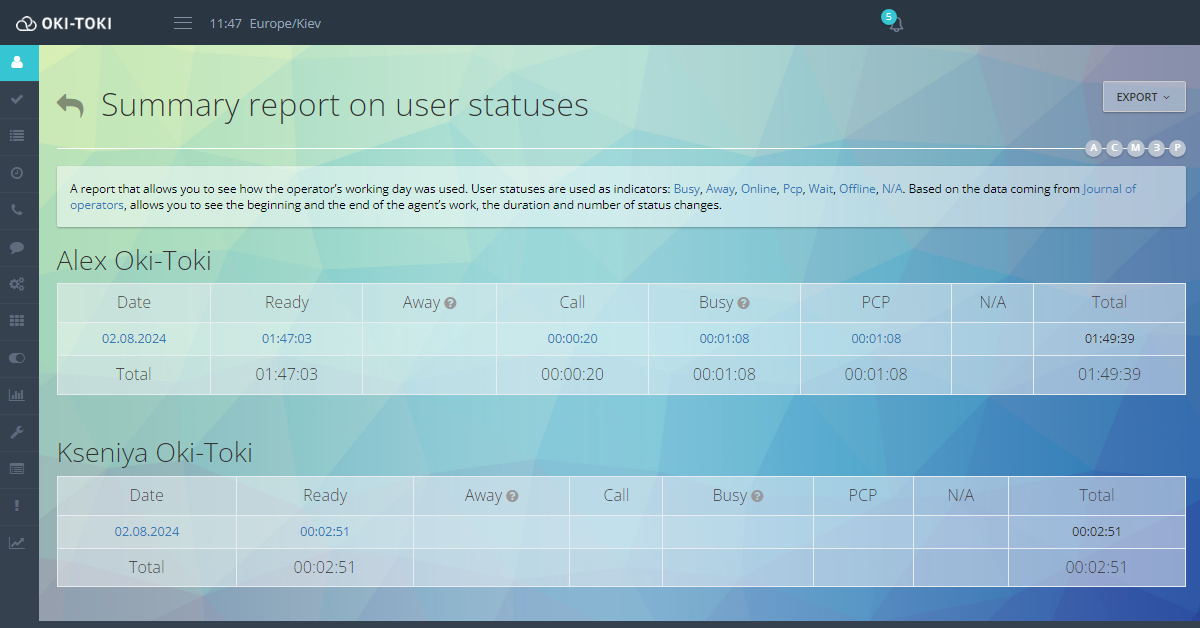
For clarity, consider the case of company X, an online store of sporting goods. Thanks to the use of a cloud service for their contact center, they were able to reduce customer waiting time on the line by half and increase the conversion of calls into sales by 20%. This was achieved by automating call processing and more efficiently routing calls to the appropriate operators. In addition, thanks to the ability to integrate with a CRM system, operators had full access to customer purchase history, which allowed them to provide personalized service and significantly increased customer satisfaction.
In conclusion, cloud service for call centers and contact centers offers a wide range of benefits and opportunities for organizations. Flexibility, scalability, geographic freedom and rich functionality make it an attractive solution for sales departments, supervisors and managers. This innovative approach has already proven its effectiveness in real practice, improving productivity and customer service.
A set of skills and tools for effective remote management of managers contact center
Managing remote contact center managers is a complex task that requires a specific set of skills and the use of specialized tools. In the context of modern technologies and the development of cloud services, effective remote management is becoming an increasingly important aspect of the work of call centers, contact centers, sales departments and other organizations.
To successfully manage remote contact center managers, you must have the following skills:
- Communication skills: Communication with remote managers is carried out primarily through electronic communication channels such as email, chats and video conferencing. It is important to be able to clearly express your thoughts, be literate in written communication and be able to effectively use various means of communication.
- Leadership Skills:Remote contact center managers require clear direction and direction. A leader must be able to set clear goals, assign tasks and provide support and motivation to achieve set goals.
- Ability to work with technology: Modern cloud services provide many tools for remote management. The contact center manager must be familiar with the basic functions of these tools and know how to use them correctly. For example, using a CRM system to track the work of managers, KPI monitoring and data analysis.
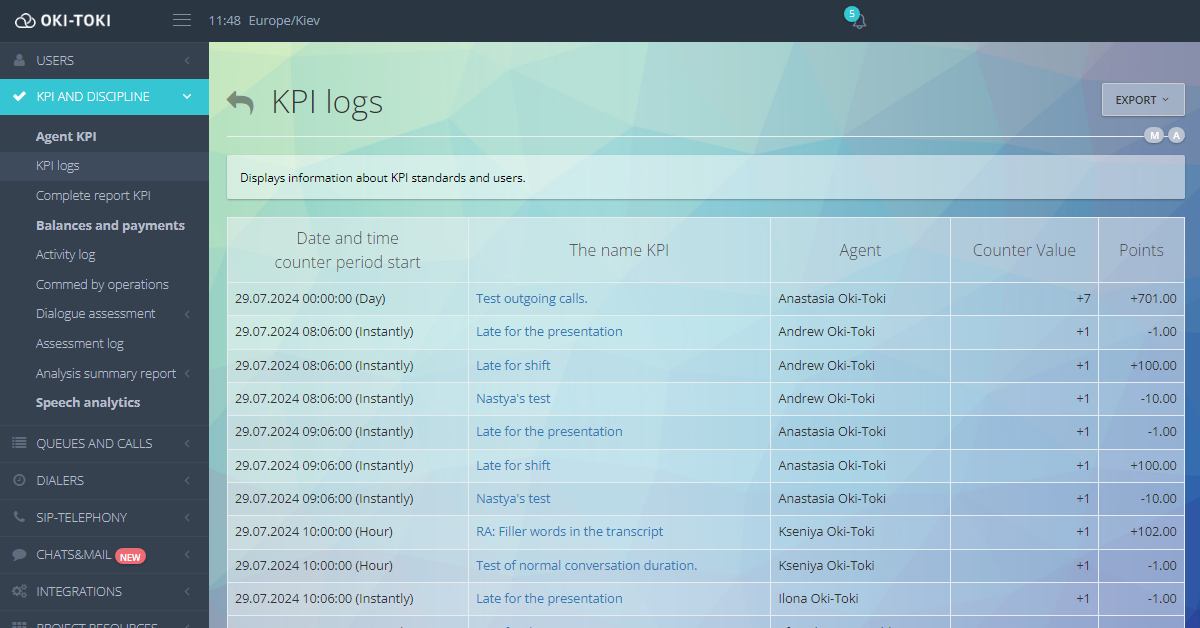
- Motivation and support: Remote employees often experience a feeling of separation from the team and loss of motivation. The manager must pay special attention to the motivation of remote managers, create conditions for their development, provide support and encourage achievements.
Together with skills, it is important to use specialized tools for effective remote management. Some of these tools include:
- CRM systems:Using a CRM system allows contact center managers to track the work of managers, manage the client database, analyze performance indicators and make management decisions based on the data received. span>
- Video conferencing systems:Video conferencing enables effective communication and communication between remote managers and the supervisor. They allow you to hold meetings, trainings, discuss issues and solve problems in real time.
- Collaborative tools :The use of shared platforms and tools allows remote managers to effectively collaborate, exchange information, work on common projects and coordinate their actions.
- Monitoring and analytics systems: The use of such systems allows the contact center manager to receive real time data on the work of managers, evaluate their performance, analyze trends and forecast the needs of the contact center.
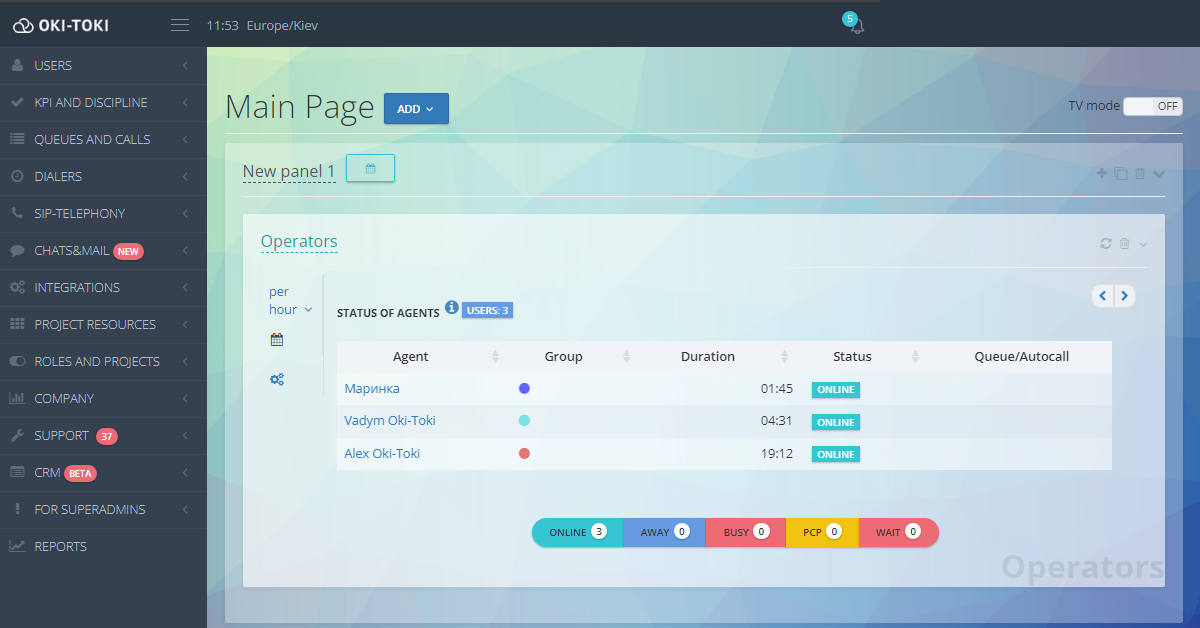
Applying the skills and tools to effectively manage contact center managers remotely improves productivity, reduces costs and enables more flexible work arrangements. These methods and tools have been successfully applied in various organizations, including online stores and financial institutions, and have led to improved customer service and increased competitiveness.
Impact of remote management on KPIs and call center productivity
Remote management is becoming increasingly common in modern organizations, including call centers, contact centers, sales departments and other departments. However, before deciding to switch to remote management, it is necessary to assess its impact on key performance indicators (KPIs ) and overall call center productivity.
One of the main aspects to consider when analyzing the impact of remote management is its potential impact on motivation and engagement of call center employees. It’s important to remember that remote workers don’t have the opportunity to communicate and interact with colleagues in person, which can impact their motivation and team spirit. However, with the help of effective communication tools and strategies, remote employees can remain connected and engaged in the team’s work.
One of the key indicators of call center performance is call response time (Average Speed of Answer, ASA). The move to remote management may impact this time, as remote workers may have different technical capabilities and access to information. Optimizing the workflow and using specialized tools for monitoring and managing calls will help reduce call response time and maintain KPI at the required level.
Another important indicator that you should consider whether the conversion of calls into sales or the completion of targeted actions (Conversion Rate). Remote management can affect the effectiveness of communication with customers and, therefore, conversion. However, through the effective use of CRM systems, employee training and data analysis, you can optimize the call processing process and increase conversion.
To assess the overall call productivity center often uses indicators such as the number of calls processed per unit of time (Calls Handled per Hour) and the average duration of call processing (Average Handling Time). Remote management can impact these metrics because remote workers may have different skill levels and access to resources. Regular training and monitoring of the work of remote employees will help identify weaknesses and improve the overall productivity of the call center.
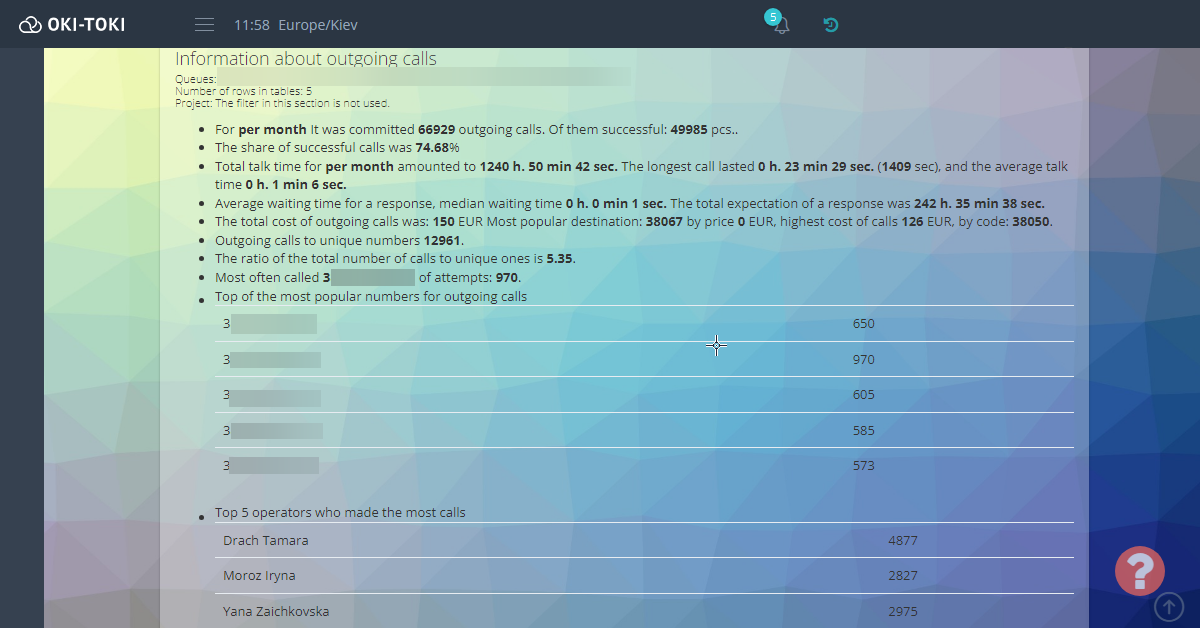
It is also worth mentioning the role of technologies and remote management tools in increasing KPIs and call center productivity. The use of cloud services, CRM systems, process automation and other tools can significantly improve the efficiency of a call center and increase its KPIs. Examples of successful implementation of remote management can be found in many industries, including online stores and financial institutions, where remote sales teams ensure high conversion and customer satisfaction.
The move to remote management in contact centers can have both positive and negative impacts on KPIs and productivity. It is important to analyze and prepare for changes, optimize communication processes, provide employees with the necessary tools and training, and regularly monitor and analyze performance indicators to achieve success in remote call center management.
The role of the supervisor in the remote management of call center operators
Modern technologies and the development of the Internet have led to the emergence of remote call centers, where operators work from different places, including home. In such conditions, the role of the supervisor is especially important, which ensures effective management and control of operators on a remote basis. Let’s consider the key aspects and tasks that a supervisor faces in remotely managing call center operators.
- Setting goals and objectives. The supervisor plays an important role in setting the goals and objectives of call center agents. It should provide an understanding of expected results and customer experience. For example, a supervisor might set key performance indicators (KPIs) for each agent, such as call handling time, customer satisfaction, or sales volume. It also tracks and evaluates the achievement of these goals.
- Training and development. The supervisor is responsible for the training and development of call center operators. He must provide them with the necessary knowledge and skills to effectively perform their duties. This may include training new employees, conducting training on customer service, using a CRM system, or conflict resolution. The supervisor also provides ongoing training and support to operators, helping them improve their productivity and service quality.
- Motivation and support. The supervisor plays an important role in supporting and motivating call center agents. He encourages them to achieve, recognizes their successes and offers rewards for good work. The supervisor also helps operators deal with problems or stress, provides moral support, and creates a positive work environment. This may include holding motivational events, encouraging team spirit or organizing rewards.
- Communication and FeedbackThe supervisor provides effective communication between operators and management. It provides operators with information about important updates, new policies, or changes to operational processes. The supervisor also collects feedback from operators, suggests improvements, and initiates changes in the work system if necessary. It serves as a link between operators and management, providing an effective communication environment.
- Monitoring and control The supervisor continuously monitors the work of operators and controls their productivity. This includes listening to calls and their recordings, reading correspondence with clients, analyzing statistical data and reports. The supervisor actively examines each operator’s performance, identifies weaknesses, and suggests adjustments and improvements. For example, if the operator needs additional support or additional training, the supervisor may assign him a mentor or provide additional training.
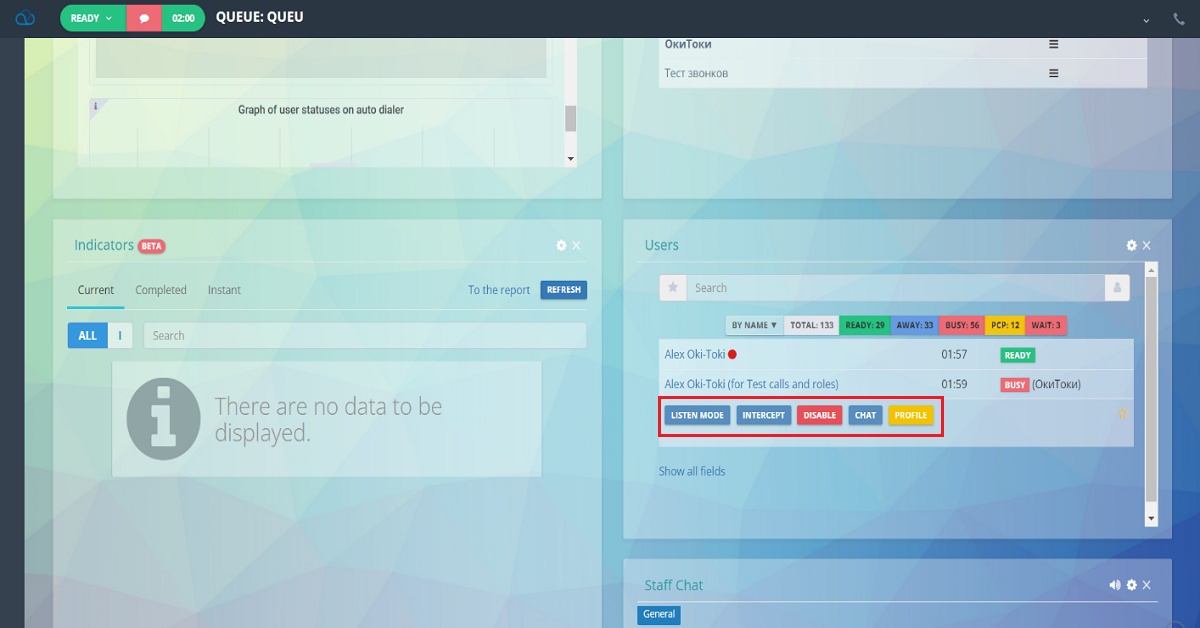
The role of the supervisor in the remote management of call center agents is critical to ensuring efficiency and quality of customer service. He plays the role of mentor, coach, motivator and communicator, helping operators develop and achieve their goals. Understanding these challenges and applying practical tips and techniques based on experience in call centers, contact centers and sales teams allows supervisors to effectively manage remote agents and provide a high level of service.
Strategies and techniques for effective remote management
Properly organized remote management can improve productivity, retain talented employees, improve customer service and achieve maximum efficiency of business processes.
The following are several key strategies and techniques that can be adopted to achieve effective remote control.
- Establish clear communication channels:For successful remote management, it is necessary to establish reliable communication channels , which will allow managers and employees to interact effectively. It is important to provide various communication tools such as video conferencing, chat, email and project management systems . This will help maintain constant communication, share information and resolve emerging issues in real time.
- Goal Setting and Planning: In a remote environment, it is especially important to have clear goals and work plans. Managers must define specific tasks and deadlines, and evaluate the progress and performance of employees. The use of project management systems and task planners will help streamline the work process and track the implementation of set goals.
- Employee motivation and support: When working remotely, it is especially important to ensure employee motivation and support. Managers can hold regular virtual meetings and one-on-one conversations with employees to identify their needs, discuss current issues, and propose solutions. You can also create a system of incentives and bonuses to encourage employees to achieve high results.
- Employee training and development: For effective remote management, it is necessary to invest in employee training and development. Conducting webinars, trainings and online courses will help improve the skills of employees, as well as increase their professional level. You can also provide employees with access to knowledge bases, guides, and resources to help them perform their tasks effectively.
- Monitoring and analysis of results: For effective remote management, it is necessary to have a system for monitoring and analyzing work results. Managers can use special programs and tools to track employee productivity, analyze customer service quality, and identify bottlenecks in business processes. This will allow timely measures to be taken to improve the performance and effectiveness of remote management.
The use of these strategies and methods will help organizations effectively manage remote teams and achieve excellent results. They are the result of many years of experience in the field of remote management and are practically proven in various business areas. Implementing these strategies will improve productivity, reduce costs, and provide quality customer service in a remote work environment.
Measuring and assessing the quality of contact center service in remote mode
The remote operating mode presents its own characteristics and raises a number of questions: How to measure and evaluate the quality of service in a remote environment? What indicators should be taken into account and how to interpret them? How to improve customer service and satisfaction while working in a remote team?
Definition of key performance indicators:
- Average Wait Time – the time that clients spend waiting for a response from the contact center operator.
- Talk Time – the duration of the conversation between the operator and the client.
- Average Handling Time – the sum of the waiting time and talk time.
- Service Level – percentage of calls, processed in a given time interval (for example, 80% of calls should be processed in 20 seconds).
- Customer Satisfaction Score – surveys and customer reviews that allow you to assess their level of satisfaction with the service.
Using tools for monitoring and analysis:
- The contact center can use special CRM systems and cloud services for recording and monitoring calls, analyzing performance indicators and managing operator tasks.
- It is important to regularly analyze data and measure service quality indicators to identify problem areas and take corrective measures.

Development of a service quality assessment system :
- Creating a service quality rating scale based on key performance indicators.
- Conducting regular audits and service quality assessments to identify problem areas and develop action plans.
Operator feedback and training:
- Regular feedback from contact center operators helps to identify and correct problems in their work.
- Conducting training and education aimed at increasing the skills of operators and improving quality of service.
Case study: Company XYZ, Internet -an electronics store, decided to transfer its contact center to remote operation. To measure and evaluate the quality of service in the new conditions, key indicators were identified: average waiting time, talk time and total call processing time. The company also used a cloud service to record and analyze calls. Through systematic monitoring and feedback from operators, XYZ was able to identify problem areas and provide employee training, resulting in improved service levels and customer satisfaction.
B As a result, measuring and assessing the quality of remote contact center service is important tasks to achieve a high level of customer experience. The correct selection of key performance indicators, the use of tools for monitoring and analysis, the development of an assessment system and feedback from operators will improve the quality of service and achieve success in remote work of the contact center.
Technologies and methods of quality control in a remote call-center
Quality control technologies and techniques play an important role in the effective functioning of a remote call center. With the growing number of companies providing remote customer service, it is necessary to provide a high level of quality service to meet the needs and expectations of customers. In this context, identifying and applying appropriate quality control technologies and techniques becomes an integral part of successful call center operations.
One of the important quality control technologies is monitoring calls. This is a process in which call center supervisors and managers listen to and analyze recordings of telephone conversations between agents and customers. Call monitoring allows you to evaluate the professionalism of the operator, the accuracy and completeness of the information provided, as well as his ability to effectively communicate with clients. To achieve the best results, you can use rating scales that allow you to score agents on various parameters, such as clarity of expression, friendliness and ability to solve customer problems.
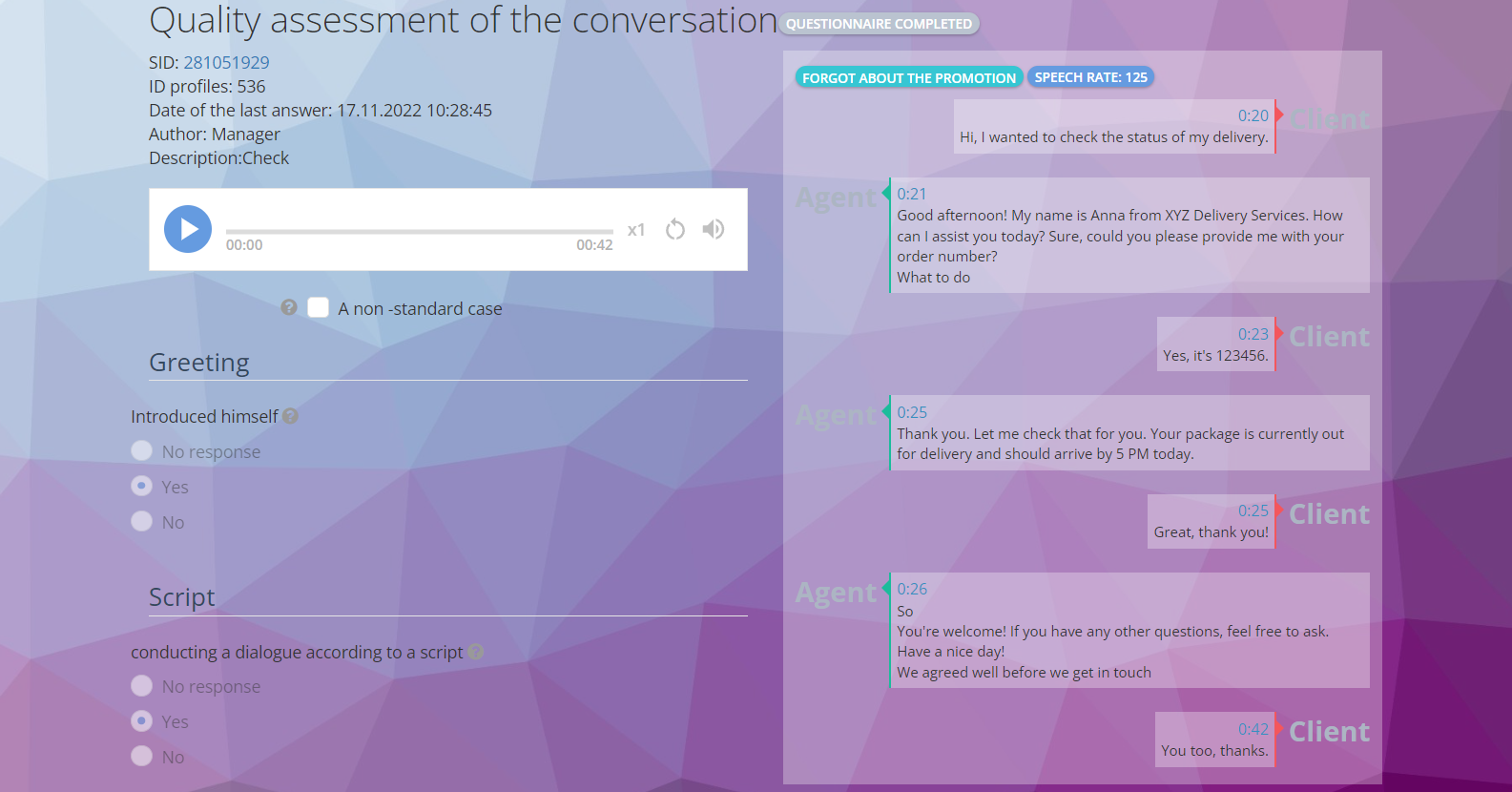
In addition to call monitoring, there are other quality control techniques such as evaluating emails and chats. More and more companies provide the opportunity for customers to communicate with operators not only by phone, but also through email and online chats. It is important to analyze the quality of these forms of communication to ensure that operators are providing a high level of service across all communication channels.
Additionally, modern technology makes it possible to automate the process quality control. Using software to monitor and analyze calls, emails and chats makes the job of supervisors and managers much easier. These tools allow you to automatically track and record key service quality parameters, as well as identify weaknesses and areas for improvement. Such systems also provide the ability to generate reports and analytics, which allows you to make informed decisions based on evidence.
It is important to note that the successful application of control technologies and techniques quality in a remote call center requires not only their implementation, but also the participation and support of the entire team. Operator training, regular training and feedback are integral parts of this process. Only through continuous improvement and exchange of experience can high standards of service quality be achieved.
Quality control technologies and techniques play an important role in a remote call center, guaranteeing high level of customer service. Monitoring calls, evaluating emails and chats, and automating the follow-up process can help improve operational efficiency and identify areas for improvement. Joint participation of the entire team and continuous improvement are key factors for the successful application of these technologies and techniques in the practice of a remote call center.
More about Tools for Call Center Manager and Call automation -center there is information on our website.
Keeping agents engaged and motivated at a distance.
Creating an effective system to support the involvement and motivation of operators at a distance is an important task for managers and supervisors. They must ensure communication, motivation and development of employees, even without the opportunity meet them in person.
To successfully implement this task, it is recommended to use the following approaches:
- Clearly define goals and expectations: It is important to ensure clarity and understanding of what is expected of operators when working remotely. Define specific goals and results that need to be achieved. Formulate them in a way that makes it clear how they can be measured and assessed.
- Regular communication and feedback communication:Regular communication channels play an important role in keeping agents engaged and motivated. Use various means of communication such as email, video conferencing, online chat or voice messaging to keep in constant touch with employees. Provide regular feedback on their performance, recognize their achievements, and provide support when needed.
- Opportunities for development:Providing agents with opportunities for professional growth and development helps keep them motivated while working remotely. Offer them training programs, online courses or virtual training that will help them develop in their professional field. Such opportunities allow operators to feel that their competencies are valued and developed.
- Recognition and encouragement: Organize a system for recognizing and rewarding the achievements of operators in remote work. This could be in the form of public praise, virtual awards, or special bonuses. Recognition and encouragement motivate operators and help them feel important and valuable to the team and the organization.
Applying these approaches in the practice of remote work in call centers, contact centers, sales departments and financial structures has already shown its effectiveness. For example, in company X, the introduction of a weekly video conference system where achievements and goals were discussed led to an increase in employee motivation by 15% in the first quarter.
The implementation of such practices in organizations helps maintain high involvement and motivation of operators when working remotely. This helps to increase productivity and quality of work, and also strengthens connections between employees and management, despite the physical distance.
Advantages of using the Oki service – Currents for remote management of a contact center
Oki-Toki is an innovative service for call centers and contact centers provided by the company of the same name. It offers a wide range of features and tools that help you effectively manage operations and communications with customers.
Oki-Toki service solves a number of problems that are often encountered call centers and contact centers:
- Limited solution capabilities: Oki-Toki offers a wide range of functionality, including PBX (PBX), internal CRM, integration with external CRM and PBX, call scripts, chats, evaluation questionnaires, transcription of conversations, auto-redial (Dialer), a software package for call center, voice robot and many other tools. This allows you to organize effective customer service and optimize work processes.
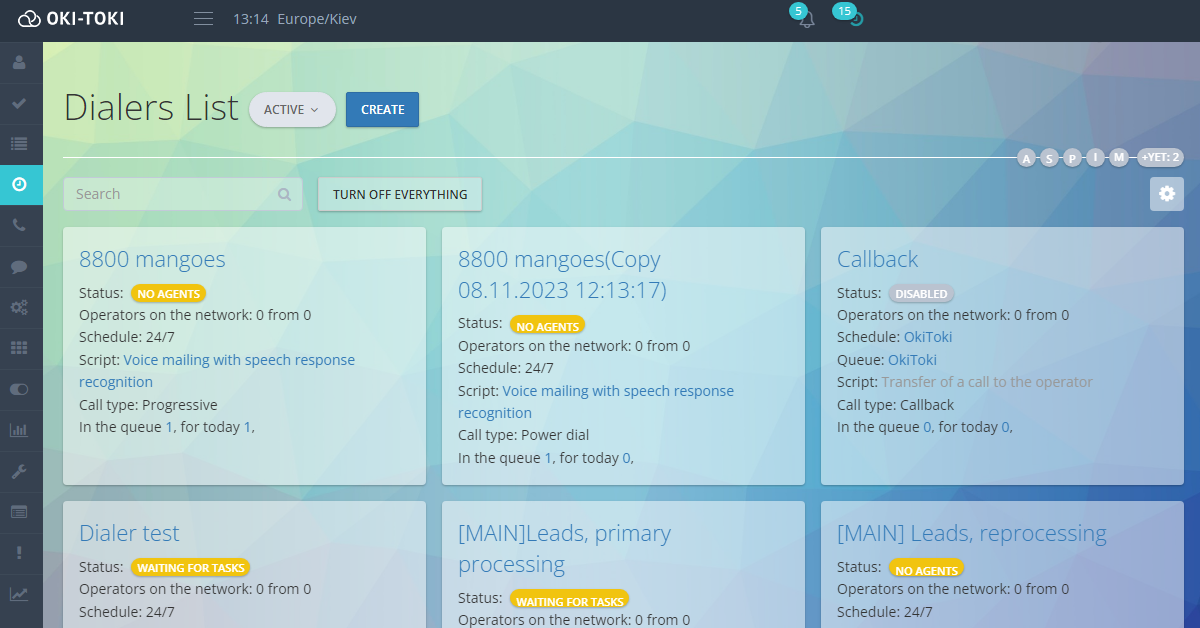
- Difficulty of setup and control:Oki -Toki has an intuitive interface that simplifies the process of setting up and managing the system. This allows you to quickly adapt to the service and start using its functionality without unnecessary difficulties.
- Insufficient analytics: Oki-Toki provides powerful analytics tools that help collect and analyze data on calls, chats and other interactions with customers. Report designer, automatically send reports by email, historical data, detailed and summary statistics, evaluation of calls and chats – all this allows you to get a complete picture of the work of the call center and make informed decisions.
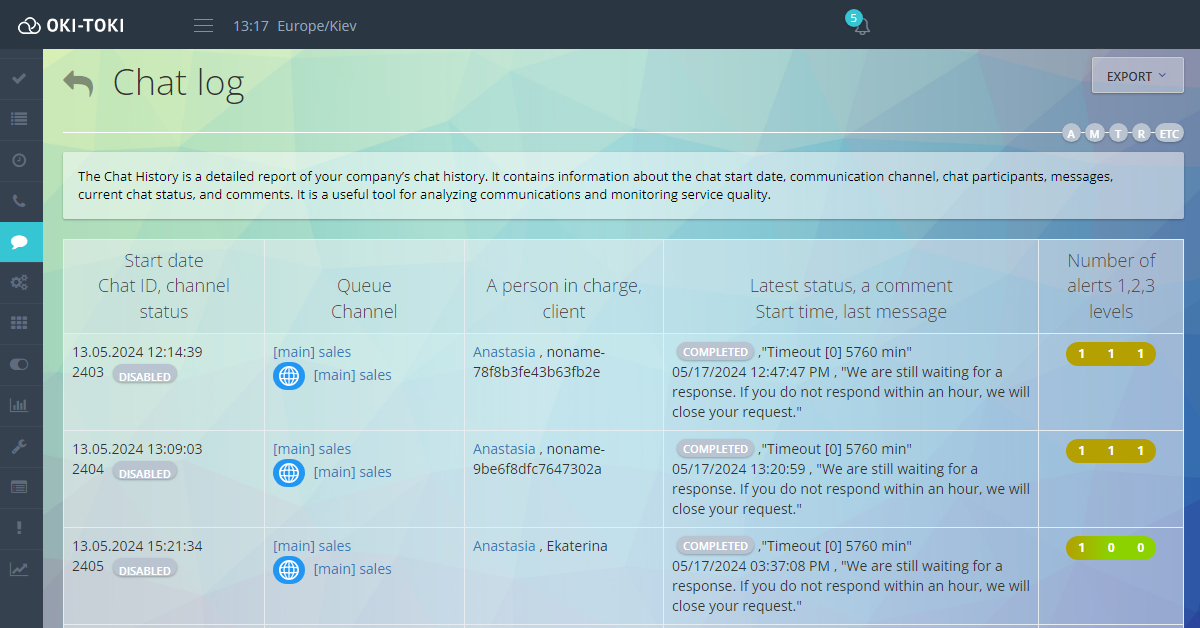
In addition, the Oki-Toki service ensures high security and protection of customer data. It offers a distributed system of access rights by role, data access control, data storage on your servers, a log of system actions and other measures to ensure the confidentiality and security of information.
It is also worth noting that Oki-Toki offers support at the initial stage, helping users with setup and training.
This is just a small overview of the Oki-Toki service and its capabilities. It provides a comprehensive solution for managing call center and contact center operations, helping to improve efficiency, improve analytics, and ensure data security.
About how to create virtual call center using Oki-Toki can be read in a separate article on our website.
Three implemented cases successful use of the Oki-Toki service
Case 1: CustomerCare
Client: CustomerCare, an international company providing contact centers for clients in various industries.
Problem:CustomerCare was experiencing limitations with its current contact center management system. They needed an intuitive and powerful tool that would help them streamline their workflows and increase efficiency.
Oki-Toki Solution: CustomerCare decided to implement the Oki-Toki service. With the help of Oki-Toki, they were able to set up their PBX, integrate external CRM systems and use automated call scripts to improve the quality of service. They also took advantage of the evaluation questionnaire feature and detailed statistics to analyze the performance of their agents and improve their communication skills with customers.
Results:
Results: Thanks to Oki-Toki, CustomerCare was able to significantly improve the customer experience and increase the efficiency of its contact center. They were able to easily set up the system and use powerful analytics tools, allowing them to make informed, data-driven decisions. The company has increased the level of customer satisfaction and improved its reputation in the market.
Case 2: TechConnect
Client: TechConnec, a leading IT services company technical support and consultation around the world.
Problem: TechConnect faced a number of problems, including the difficulty of setting up and managing its calls -centers, limited analytics capabilities and the need for secure storage of customer data.
Oki-Toki solution: TechConnect chose Oki- Toki as a solution for their call centers. They implemented the functionality of PBX (PBX) and internal CRM, and also integrated their external CRM systems. They used Oki-Toki’s analytics tools to get detailed statistics on calls and customers, and created automated reports for more effective monitoring and decision-making. They also took advantage of Oki-Toki’s security features to ensure the confidentiality of customer data.
Results: Thanks to Oki-Toki, TechConnect was able to simplify the setup and management of its call centers, improve the quality of customer service and ensure data security. They were able to effectively analyze their operations and make informed decisions based on data. This allowed the company to improve its reputation and attract new clients.
Case 3: TravelSolutions
Client: TravelSolutions, a leading travel operator providing a wide range of services and support to customers around the world.
Problem: TravelSolutions faced problems with the complexity of setting up and managing their call centers, as well as a lack of analytical tools for monitoring and improving agent productivity.
Oki’s solution Toki:TravelSolutions has implemented Oki-Toki to manage its call centers. They easily set up PBX, internal CRM and integrated them with external CRM systems. They used call scripts and chats to improve customer service, and evaluation questionnaires to collect feedback. Using Oki-Toki’s analytics tools, TravelSolutions received detailed statistics on calls and operators, which allowed them to monitor performance and improve training of their operators.
Results: TravelSolutions was able to reduce setup and management time for its call centers, improve customer service, and increase agent efficiency. Thanks to Oki-Toki analytics, they were able to identify weaknesses and take steps to improve them. This helped TravelSolutions strengthen its position in the market and increase customer loyalty.


